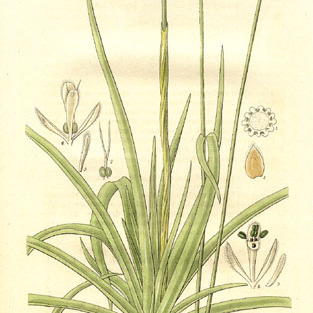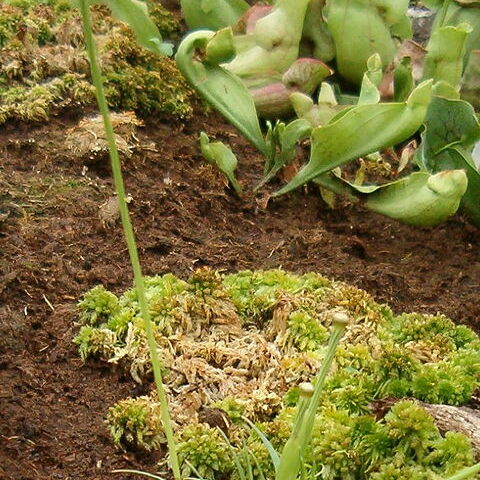Annual or perennial herbs usually under 1 m. high, often much smaller; stem usually abbreviated to a basal disc, infrequently elongate. Leaves narrow, lanceolate to filiform, spirally arranged, crowded into a basal rosette or rarely dispersed on elongate stems, opaque to translucent, sometimes fenestrate. Inflorescence capitate, single or in umbels, on leafless ribbed scapes. Capitula composed of many small (often tiny) unisexual flowers on a central receptacle surrounded by 1–several whorls of involucral bracts, monoecious, each flower often subtended by a floral bract. Flowers trimerous or less often dimerous, subactinomorphic to strongly zygomorphic. Perianth usually composed of two distinct whorls, sometimes reduced or absent; calyx of free, partially or almost completely connate sepals, sometimes spathe-like especially in the male flowers; petals free or partially connate, spathulate to filiform, frequently hairy, often with a subapical black gland; male petals often fused with the floral axis to form an infundibular structure topped by very small free lobes. Male flowers with stamens as many or twice as many as the sepals; inner whorl epipetalous; a vestigial gynoecium usually present. Female flowers with a superior 2–3-locular ovary; style simple, tipped with 2, 3 or 6 elongate stigmas. Fruit a thin-walled, loculicidally dehiscent capsule, each locule containing a single seed
Herbs, annual or perennial, monoecious, rarely dioecious. Leaves alternate, usually rosetted, rarely cauline, parallel-veined and grass-like, lacking well-developed sheath. Inflorescence a dense, white to cream or grey to black head usually terminating a peduncle, rarely sessile, subtended by an involucre of bracts. Flowers generally subtended by a bract, often stipitate, 2–3-merous, actinomorphic or zygomorphic, hypogynous, unisexual, both sexes intermingled in the same head, or the female flowers marginal, rarely heads unisexual. Sepals 0–3, free, or connate to form a lobed tube or spathe-like scale. Petals 0–3, free, often separated from outer perianth segments by expansion of androphore or gynophore. Stamens in dimerous flowers 2 or 4, in trimerous flowers (3)–6; filaments adnate to the corolla tube or appearing to rise from apex of androphore; anthers usually 2-celled, opening by longitudinal slits. Gynoecium of 2 or 3 carpels, connate, superior, often stipitate; ovary with as many cells as carpels; ovules 1 per cell; style terminal, stigmatic branches as many as carpels, simple or bifid, linear, often with appendages. Capsule loculicidal.
Herbs perennial or annual. Leaves in a rosette, grasslike, linear, occasionally thinly filiform, often thin and transparent, fenestrate, base sheathing. Inflorescences capitate, globose to ovoid; scapes thin, twisted, angled, base surrounded by a bladeless, tubular sheath. Flowers 2-or 3-merous, bracteate, with both sexes usually in same head. Male flowers: sepals 2 or 3, connate or free; petals 2 or 3, often inconspicuous; stamens 6. Female flowers: sepals 2 or 3, free or connate; petals absent to 4, free; ovary (1--)3-loculed; ovules 1 per locule, basal; style 1, 1--3-branched. Fruit a capsule, thin, loculicidal. Seeds small; testa usually reticulate and prickly; endosperm with abundant starch grains.
Inflorescence an involucrate capitulum comprising numerous small, densely crowded flowers often subtended by floral bracts; peduncle leafless, unbranched, usually arising from a well-developed basal sheath; flowers unisexual, the males and females mixed in the same capitulum, or the males in the middle and the females around, or rarely males and females in separate capitula; perianth membranous or scarious, the segments usually in 2 distinct series, the outer segments ("sepals") generally free in female flowers, often connate in male, the inner ("petals") free or rarely connate in female flowers, connate and often very reduced in male flowers
Ovary 2-3-locular, ovules solitary, pendulous in each loculus; style usually distinct, divided above into 2-3 elongate, simple (or occasionally bifid) stigmas, sometimes with alternating appendages
Annuals or perennials; stems often very short, occasionally elongate; leaves narrow, often crowded or rosulate, frequently with large, conspicuous cells
Stamens equal in number to, or twice as many as the inner perianth segments; anthers 2-thecous, or less often 1-thecous, introrse
Fruit a membranous loculicidal capsule; seeds relatively large, testa generally scabrid or papillose; endosperm copious


